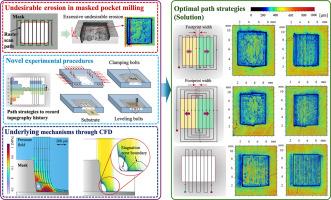遮蔽式磨料浆喷射袋铣中的侵蚀地形建模
IF 7.1
1区 工程技术
Q1 ENGINEERING, MECHANICAL
International Journal of Mechanical Sciences
Pub Date : 2024-11-13
DOI:10.1016/j.ijmecsci.2024.109830
引用次数: 0
摘要
研磨浆和水射流可与抗侵蚀掩模一起用于快速加工微孔。然而,使用掩模可能会导致不良侵蚀和掩模蚀刻不足,从而使掩模边缘附近的局部深度增加两倍或更多。虽然导致不良侵蚀的详细机制尚不十分清楚,但似乎与喷射流与掩膜边缘的相互作用有关。本文采用新型实验技术和耦合计算流体动力学/表面演变模型,首次对这些机制进行了严格研究。为了展示这些技术,本文考虑了使用 SS304 掩膜对铝 6061-T6 进行研磨浆喷射微加工的问题,并采用了一种新技术来精确控制研磨浆喷射相对于掩膜边缘的位置。该模型合理准确地预测了各种情况下的表面演变和不良侵蚀,以及掩模蚀刻不足的物理现象。研究发现,相对于掩膜边缘的喷射位置和扫描方向对不良侵蚀的程度有很大影响。模型表明,掩模铣削的停滞区小于无掩模铣削,这有利于在掩模边缘附近形成浆料再循环区,再加上从掩模边缘跳射的粒子,共同作用产生了不良侵蚀和蚀刻不足。基于对这一问题的进一步了解,我们提出了几种路径策略,发现这些策略可以最大限度地减少不良侵蚀,从而可以铣出深度更均匀的凹槽。本文章由计算机程序翻译,如有差异,请以英文原文为准。

Modeling eroded topography in masked abrasive slurry jet pocket milling
Abrasive slurry and water jets can be used together with erosion-resistant masks to rapidly machine micro-pockets. However, the use of masks can result in an undesirable erosion and mask under-etching which can locally increase the depth twofold or more in the vicinity of the mask edges. Although the detailed mechanisms leading to the undesirable erosion are not well understood, they appear to be related to the interaction of the jet flow with the mask edge. This paper employs novel experimental techniques and coupled computational fluid dynamics/surface evolution models to rigorously study these mechanisms for the first time. To demonstrate the techniques, the abrasive slurry jet micromachining of pockets into Al 6061-T6 using SS304 masks was considered, using a novel technique to precisely control the position of the abrasive slurry jet relative to the mask edge. The model reasonably accurately predicted the surface evolution and undesirable erosion in various scenarios, as well as the physics of mask under-etching. The position of the jet relative to the mask edge and the scanning direction were found to strongly affect the extent of undesirable erosion. The model suggests that the stagnation zone in masked milling is smaller than that in unmasked milling, and that this facilitates the formation of slurry recirculation zones near the mask edges which, together with particle ricochets off the mask edge, interact to create the undesirable erosion and under-etching. Based on this improved understanding, several path strategies were presented that were found to minimize the undesirable erosion and thus allow the milling of pockets with more uniform depths.
求助全文
通过发布文献求助,成功后即可免费获取论文全文。
去求助
来源期刊

International Journal of Mechanical Sciences
工程技术-工程:机械
CiteScore
12.80
自引率
17.80%
发文量
769
审稿时长
19 days
期刊介绍:
The International Journal of Mechanical Sciences (IJMS) serves as a global platform for the publication and dissemination of original research that contributes to a deeper scientific understanding of the fundamental disciplines within mechanical, civil, and material engineering.
The primary focus of IJMS is to showcase innovative and ground-breaking work that utilizes analytical and computational modeling techniques, such as Finite Element Method (FEM), Boundary Element Method (BEM), and mesh-free methods, among others. These modeling methods are applied to diverse fields including rigid-body mechanics (e.g., dynamics, vibration, stability), structural mechanics, metal forming, advanced materials (e.g., metals, composites, cellular, smart) behavior and applications, impact mechanics, strain localization, and other nonlinear effects (e.g., large deflections, plasticity, fracture).
Additionally, IJMS covers the realms of fluid mechanics (both external and internal flows), tribology, thermodynamics, and materials processing. These subjects collectively form the core of the journal's content.
In summary, IJMS provides a prestigious platform for researchers to present their original contributions, shedding light on analytical and computational modeling methods in various areas of mechanical engineering, as well as exploring the behavior and application of advanced materials, fluid mechanics, thermodynamics, and materials processing.
 求助内容:
求助内容: 应助结果提醒方式:
应助结果提醒方式:


